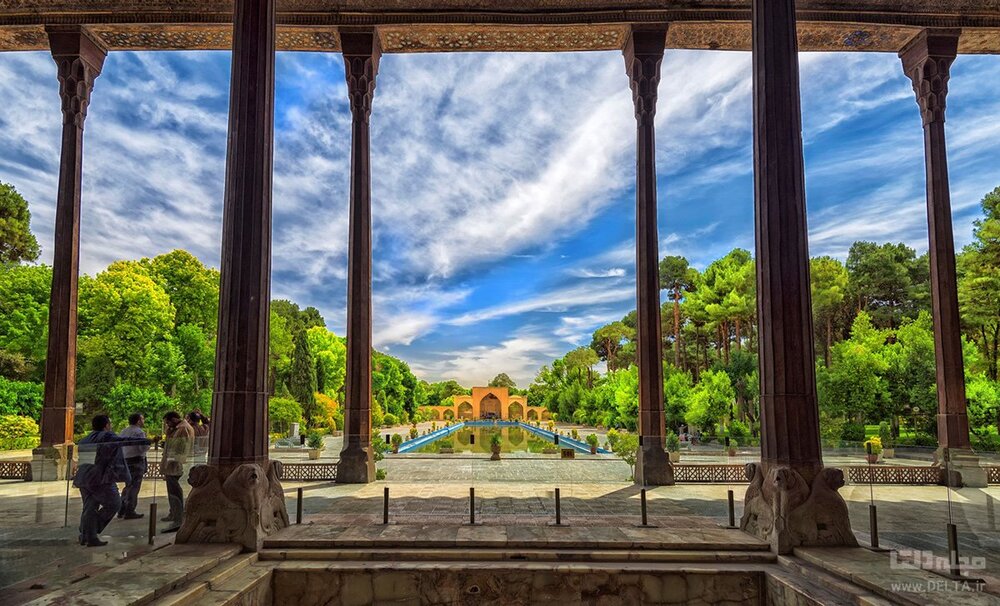Kakh-e Chehel Sotoun: do not let the illusion of columns deceive you!

TEHRAN – The beautifully proportioned Kakh-e Chehel Sotoun is a prime example of a royal garden left from the Safavid era (1501-1736). The meaning of its name is a palace with 40 columns.
Situated in Isfahan, which has a world reputation for being an artistic and historical city, Kakh-e Chehel Sotoun is entered via an elegant terrace that perfectly bridges the transition between the Persian love of gardens and interior splendor.
The main structure is built as a pleasure pavilion and reception hall, using the Achaemenid-inspired talar (columnar porch) style.
Before entering the palace, there is a veranda with 20 cypress wood columns. Nevertheless, as the name Chehel Sotoun suggests, there have to be 40 columns. The reflection of the 20 real columns on the water of the pool, creates the illusion that there are 40 columns. It is worth mentioning that the number 40 in Iran signifies multiplicity in general. Therefore, we can conclude that there was a great contemplation behind building such an amazing structure.
It is the only surviving palace on the once royal precinct stretched between the gigantic Imam Sq and Chahar Bagh Abbasi St. Kakh-e Chehel Sotoun is reputed to date from 1614; an inscription uncovered in 1949, suggests it was completed in 1647 under the watch of Shah Abbas II.
According to Lonely Planet, the palace’s Great Hall (Throne Hall) is a gem, richly decorated with frescoes, miniatures, and ceramics. The upper walls are dominated by historical frescoes on a grand scale, sumptuously portraying court life and some of the great battles of the Safavid era – the two middle frescoes date from the Qajar period but the other four are original.
From right to left, above the entrance door, the armies of Shah Ismail do battle with the Uzbeks; Nader Shah battles Sultan Mohammed on an Indian battleground, and Shah Abbas II welcomes King Nader Khan of Turkestan with musicians and dancing girls.
On the wall opposite the door, also from right to left, Shah Abbas I presides over an ostentatious banquet; Shah Ismail battles the janissaries of Sultan Selim; and Shah Tahmasp receives Humayun, the Indian prince who fled to Persia in 1543.
These extraordinary works survived the 18th-century invasion by the Afghans, who whitewashed the paintings to show their disapproval of such extravagance. Other items, including Safavid forebear Safi al-Din’s hat, are kept in a small museum.
The palace’s garden (Bagh-e Chehel Sotun) is an excellent example of the classic Persian Garden, which is registered on the UNESCO World Heritage list.
The genuine concept of the Persian Garden that is deeply rooted in time interweaves natural elements with manmade components to embody an idea of creating a paradise on Earth by the means of artistic, philosophical, figurative, and religious notions.
The UNESCO website asserts that the flawless design of the Persian Garden, along with its ability to respond to extreme climatic conditions, is the result of an inspired and intelligent application of different fields of knowledge, i.e. technology, water management and engineering, architecture, botany, and agriculture.
Soaked in a rich history and culture, Isfahan was once a crossroads of international trade and diplomacy in Iran. Now, it is one of Iran’s top tourist destinations for good reasons.
The city has long been nicknamed as Nesf-e-Jahan which is translated into “half the world”; meaning seeing it is relevant to see the whole world. In its heyday, it was also one of the largest cities in the region with a population of nearly one million.
The huge Imam Square, best known as Naghsh-e Jahan Sq. (literary meaning “Image of the World”), is one of the largest in the world (500m by 160m), and a majestic example of town planning.
The main gate of Chehel Sotoun opens to Sepah Street, next to Isfahan Municipality. Therefore, in the case of using public transportation, Municipal Bus Station is quite close to the palace. Other attractions nearby that you really have to visit are Naghsh-e Jahan Square, Hasht Behesht Palace, Sheikh Lotfollah Mosque, Ali Qapu Palace, Qeysarieh Gate (The Grand Bazaar), and Imam Mosque.
Under travelers’ eyes
Here is a selection of comments that visitors to the garden palace have posted to TripAdvisor, one of the most popular travel websites in the world:
“Soooo beautiful”
It is a beautiful palace called 40 colons, it has 20 and with the reflection in the water is 40 ....beautiful paintings, interesting architecture, and a very beautiful garden. It is one of the most beautiful places to see in Isfahan. (Taffoolie from Paris, France)
“Serene garden palace”
Beautiful grounds around a large pool lead to the Palace. Inside you will find lovely murals depicting the life of the ages. Sit in the park and enjoy the serenity. (DL2Some from Detroit Lakes, MN)
“Undergoing extensive renovation at the moment but still stunning nonetheless”
The quintessential Persian garden complex with a huge palace at one end features some beautiful artwork and geometric patterns on the ceilings and outdoor woodwork. (DominicDeBurca from Dunmore East, Ireland)
“Nice place to visit”
The paintings inside the building are nice and the columns which are mostly out of wood are something special. 20 columns which are holding the ceiling are reflected in the water and become 40, and they call it Chehel Sotoun!! (berta Moretti from Genoa, Italy)
“Beautiful palace”
Well worth a visit in a country where there are many beautiful palaces this still stands out. The paintings inside are remarkable but there is a calmness about this place which makes it a lovely place to visit.
Many moments in Persian history are captured in the paintings inside. A very photogenic place. (Frankie T from Belfast, UK)
AFM
Leave a Comment